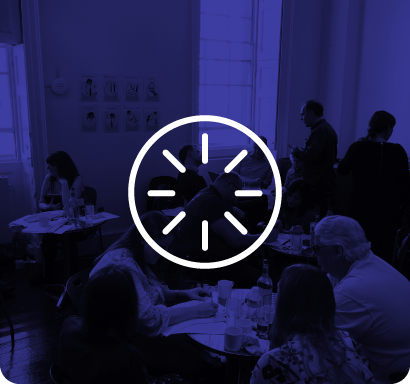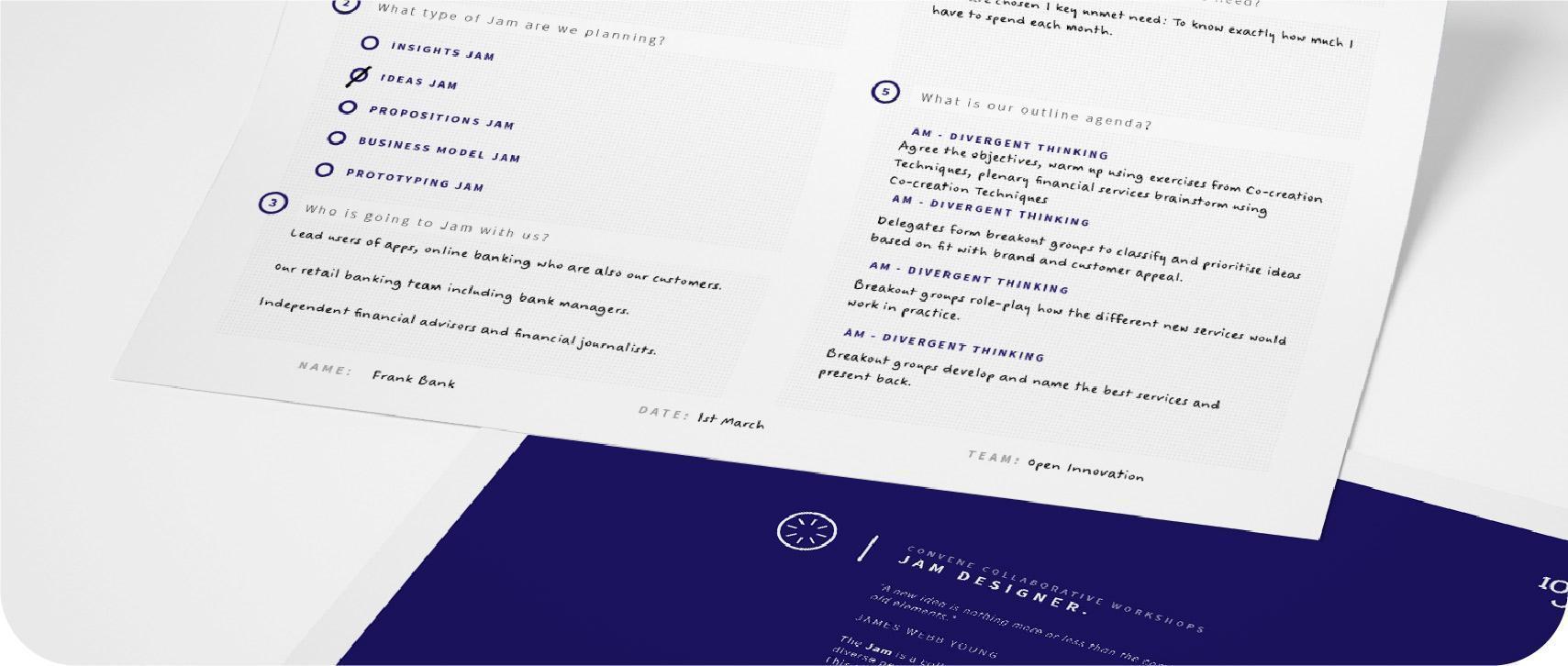The Jam is a collaborative style of workshop that deliberately mixes diverse people and disciplines to find new powerful hybrid ideas. This tool is a ‘how to’ for planning a productive and creative session for new ideas, propositions, business models or prototypes. Getting colleagues or partners involved in a Jam also helps get buy-in and maintain momentum throughout the innovation process.


"It's very hard to write a song alone. It's only by jamming that you can get a song together."
Maurice Gibb
A Jam workshop depends on three main ingredients:
– A diversity of attendees with different backgrounds, different personalities or from different organisations
– Extreme collaboration in every activity from the warm up to the final presentation
– Two alternating thinking styles; divergent (creative) and convergent (analytical)
We will design our Jam around this typical flow:
AM – Divergent thinking: Agree the objectives, warm up and brainstorm using exercises from the Co-creation Techniques tool
AM – Convergent thinking: Delegates form breakout groups to classify and prioritise ideas
PM – Divergent thinking: Breakout groups brainstorm or role-play how to push ideas further
PM – Convergent thinking: Breakout groups hone and select the best options and present back
1. What are the Jam’s objectives?
We choose a specific objective that fits the stage of innovation we’re at: Are we seeking to co-create insights, new product or service ideas, propositions, business models or prototypes? Are we after quality or quantity of outputs? What are we planning to do with them?
2. Who is going to Jam with us?
Productive Jams are all about the clash of cultures and the collision of perspectives. Clearly we need to invite any existing stakeholders to the project. We also include any collaboration partners or people from relevant innovation networks. It’s a good idea to invite (and pay for) some neutral domain experts, whether practitioners or academics.
3. What stimulus materials will we need?
It is crucial to prepare tasty brain food for successful creativity. This entails different flavours for different objectives:
– Unmet Needs Jam: We should pre-analyse and prepare existing market research data or even better prepare fresh insights using Social Listening or an Insight Crowd.
– Ideas Jam: Bring inspiring user insights to an Ideas Jam. When planning the workshop we will need to review any existing market research and prepare Unmet Need cards. We might also use such insights to create user Personas in the workshop. Bring along new ideas that already exist for inspiration and to avoid re-inventing the wheel.
– Proposition Jam: Bring along existing Idea Frames to develop using Pitch Templates. Consider bringing along other propositions our organisation has already invested in so we know how much detail is needed. Use an evaluative framework, like the PPP filter, in order to overcome the ‘Ikea effect’, a psychological term for the natural cognitive bias we have in favour of ideas we are involved in.
– Business Model Jam: Bring five or six examples of other business models that either compete with us in our sector or inspire us in others. Use the Collaborative Business Canvas to analyse and compare them with ours.
– Prototyping Jam: Bring along all the materials that might be needed for physical or digital prototyping – see Prototyping Techniques for examples – and organise a Service Safari during the day experience and analyse service propositions.
When designing a Jam we should plan time to create a record of the day afterwards, using as much visual material as possible. 100%Open always photographs all the materials for later analysis. This includes all the sticky notes and sketches. Often the idea presentations are captured on video. An efficient way of recording ideas is to use Idea Frame to provide consistency. People are also encouraged to be as visual as possible, sketching ideas, using photography or found art to illustrate ideas or by using Sketch Templates to bring ideas alive.
HOW THIS TOOL FITS IN WITH OTHERS
Warm up and brainstorm using exercises from Creativity Techniques.
In an Ideas Jam use Idea Frame to provide consistency and Sketch Templates to bring ideas alive.
For an Unmet Needs Jam prepare fresh insights using Social Listening or an Insight Crowd and use Unmet Need cards to record the outputs.
Use Personas in any Jam to bring the user alive.
For a Proposition Jam use Pitch Templates to formalise the proposition and PPP filter to aid judgement.
In a Business Model Jam use the Collaborative Business Canvas for analysing models.
For a Prototyping Jam see Prototyping Techniques and Service Safari for a productive day.
